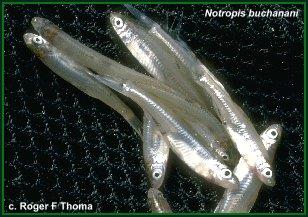Fish Iowa - Fish Species - Ghost shiner

Characteristics
A pale, deep and slab-sided minnow with large eyes and a small, oblique mouth with no barbels. Anal fin with 8 (rarely 7 or 9) rays. The front of dorsal fin base is about equal distance between the tip of the snout and base of the tail fin. Depth of the scales in the lateral line become greater toward the head. Tips of pelvic fins reach to or beyond the front of the anal fin (except in females swollen with eggs). The dorsal fin is very high and pointed. The sensory canal beneath the eye is absent or represented only by a short section of tube. Lateral line scales are 30 to 35. Intestine short, with a single S-shaped loop, lining of body cavity silvery, without dark speckles. Ghost Shiners have a pale yellowish-white back, the scales are sometimes faintly dark-edged. Sides and belly silvery-white, usually with no dark markings of any kind; the fins are plain. Breeding males are without special colors, but have small tubercles over most of the head, forward part of body, and along rays of the pectoral fin; tubercles largest on the snout and top of head. Most adults are 1.5- to 2-inches long.
Foods
Its diet has not been studied, but probably consists mostly of insects and other small invertebrates.
Expert Tip
- No results found
Details
The Ghost Shiner seeks clear, quiet mid-waters of large creeks and rivers with low gradients, with clean sand and gravel bottoms and submergent vegetation, such as pondweed. It prefers gentle eddies next to strong current in pools where intermittent creeks joined rivers or gravel bars in the mainstream caused a reversal of current. The Ghost Shiner may have some resistance to reservoir construction, but has been extirpated in some places after impoundment.
The Ghost Shiner is characteristic of the low gradient sections of large creeks and rivers with permanent flow and moderately clear water. It is a quiet-water species, living in larger pools and protected backwaters without noticeable current.
The Ghost Shiner lives in schools in mid-water and is most often found close to the Mimic, Red, and Redfin Shiners. Most spawning adults are in their second summer, but a few are in their third summer. Three summers seems to be their maximum life span. Females reach a larger size than males.
Sources:
Loan-Wilsey, A. K., C. L. Pierce, K. L. Kane, P. D. Brown and R. L. McNeely. 2005. The Iowa Aquatic Gap Analysis Project Final Report. Iowa Cooperative Fish and Wildlife Research Unit, Iowa State University, Ames.
Pflieger, W.L. 1997. The fishes of Missouri. Missouri Department of Conservation, Jefferson City, Missouri. 372 pp.
Photo credit: photo courtesy of Roger F. Thoma, copyright Roger F. Thoma.
Distribution Map

State Record(s)
No state record exists for this species
Submit your potential recordMaster Angler Catches
No Master Angler catches currently exist for this species.
Submit your Master Angler catch